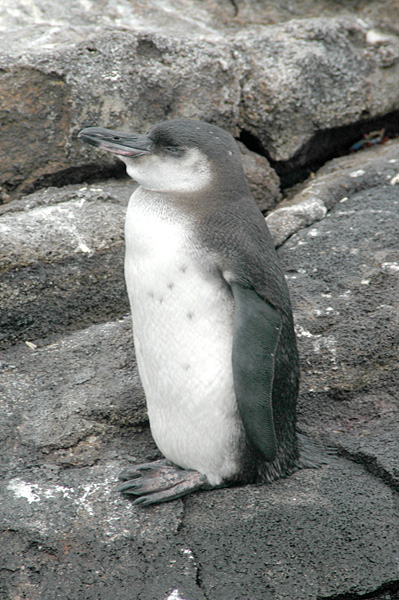|
| Query: penguin | Result: 3rd of 855 | |
Galapagos Penguin (Spheniscus mendiculus) - Wiki
| Subject: | Galapagos Penguin (Spheniscus mendiculus) - Wiki
| |

| Resolution: 399x600
File Size: 129734 Bytes
Upload Date: 2007:12:24 14:18:32
|
Gal??pagos Penguin
From Wikipedia, the free encyclopedia
Order: Sphenisciformes
Family: Spheniscidae
[Photo] Galapagos Penguin (Spheniscus mendiculus) juvenile, Galapagos Islands, Ecuador. Image taken by Clark Anderson/Aquaimages (http://en.wikipedia.org/wiki/User:Aquaimages).
The Gal??pagos Penguin (Spheniscus mendiculus) is a penguin endemic to the Gal??pagos Islands. It is the only penguin to live on the equator and can survive due to the cool temperatures resulting from the Humboldt Current and cool waters from great depths brought up by the Cromwell Current. Its nearest relatives are the African Penguin, the Magellanic Penguin and the Humboldt Penguin. The Gal??pagos Penguin occurs primarily on Fernandina Island and the west coast of Isabela Island, but small populations are scattered on other islands in the Gal??pagos archipelago.
Gal??pagos Penguins grow to between 48-53 cm tall. They have a black head with a white border running from behind the eye, around the black ear-coverts and chin, to join on the throat. They have blackish-grey upperparts and whitish underparts, with two black bands across the breast, the lower band extending down the flanks to the thigh. Juveniles differ in having a wholly dark head, greyer on side and chin, and no breast-band.
The Gal??pagos Penguin mates for life. It lays one or two eggs in places such as caves and crevices, protected from direct sunlight, which can lead to the eggs overheating. One parent will always stay with the eggs or chicks while the other is absent for several days to feed. If there is not enough food available, the nest may be abandoned.
The species is endangered, with an estimated population size of around 1,500 individuals in 2004, according to a survey by the Charles Darwin Research Station. The population underwent an alarming decline of 65% in the 1980s, but is slowly recovering. It is therefore the rarest penguin species (a status which is often falsely attributed to the Yellow-eyed penguin). Population levels are influenced by the effects of the El Ni??o Southern Oscillation, which reduces the availability of shoaling fish, leading to low reproduction or starvation. However, anthropogenic factors (e.g. oil pollution, fishing by-catch and competition) may be adding to the ongoing demise of this species. On Isabela Island, the introduced cats, dogs and rats may attack penguins and destroy their nests.
http://en.wikipedia.org/wiki/Galapagos_penguin
| The text in this page is based on the copyrighted Wikipedia article shown in above URL. It is used under the GNU Free Documentation License. You may redistribute it, verbatim or modified, providing that you comply with the terms of the GFDL. |
|
Comments |
|---|
| | Guest |
|
Gal??pagos Penguin (Spheniscus mendiculus)
The Galapagos penguin is the most northerly of all penguins, occurring on the Galapagos Islands, on the equator. It is the third smallest penguin in the world and is the smallest member of the Spheniscidae family. This diminutive penguin has a black head and upperparts, with a narrow white line extending from the throat around the head to the corner of the eye. The underparts are white with two black bands extending across the breast. The upper part of the bill and the tip of the lower part of the bill are black, the rest of the bill and a bare patch around the eye and bill are pinkish yellow. Although the sexes are generally similar in appearance, males are larger than females. Juveniles have a totally dark head, and lack the dark breast bands seen in adults. This species has more bare skin on the face than other penguins; this is an adaptation to the hot temperatures experienced on the Galapagos. |
^o^
Animal Pictures Archive for smart phones
^o^
|
|
|